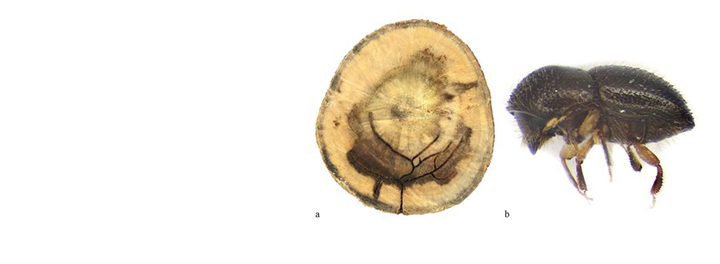Research Features
An MSc study by Kira Lynn in the RGE-FABI Tree Health Programme at the University of Pretoria has described a new Fusarium species, Fusarium rekanum sp. nov., associated with Euwallacea perbrevis, an ambrosia beetle species infesting Acacia crassicarpa plantations in Riau, Indonesia. Highlights from this work are published in an article in the journal, Antonie van Leeuwenhoek.
Non-native plantations in Indonesia have experienced a “steady” increase in beetle infestation over the years, resulting in economic losses to the country’s forestry industry. The beetle species infesting Indonesian plantations was initially identified as Euwallacea fornicatus more than 25 years ago, but taxonomic redefinitions had left the identity of the beetles and their obligate fungal associate unclear.
The aim of this study by Kira Lynn was therefore to identify the most common beetle species in the plantations and their fungal associates. The researchers also sought to determine whether these fungal associates were pathogens of A. crassicorpa.
The researchers extracted beetles and their galleries from infested trees for morphological and molecular identification. From the mycangia of mature female beetles and beetle galleries, they isolated fungi to determine the most prevalent species. Out of five beetle species collected from these trees, they identified Euwallacea perbrevis (known as the Tea Shothole Borer clade A) as the most prevalent, making up 49 percent of the samples. Because of the prevalence of E. perbrevis, the species and its fungal symbionts became the focus of this study. “The common occurrence of this beetle over a relatively wide distribution suggests that they have migrated from the natural forests into the A. crassicarpa plantations,” wrote the authors.
The researchers identified 18 fungal genera in the mycangia of the beetles and in the brood galleries in the xylem of the trees, with Fusarium species the most abundant. The researchers focused on the Fusarium species associated with E. perbrevisfor this study.
“Based on morphological and molecular evidence, the Fusarium isolates from E. perbrevis mycangia and brood galleries collected from infested A. crassicarpa represent a novel associate of the TSHBa beetle. It is consequently described as Fusarium rekanum sp. nov.,” concluded the authors.
The researchers inoculated A. crassicarpa trees with F. rekanum to determine its pathogenicity and to observe symptoms of disease. They report that the trees “showed no external signs of disease after 30 days.” They however warn that though the fungus appears to have “a low level of aggressiveness”, further studies including a “greater number of isolates” are needed to determine “whether the fungus might play a role in tree decline”. The authors observed that “the damage observed on A. crassicarpa appears to be the combination of the mechanical damage caused by mass attack of beetles, and the repeated inoculation of the weakly pathogenic Fusarium sp.”
The outcomes highlighted in this article are just part of Ms. Lynn’s study, in which she described seven new Fusarium species associated with two Euwallacea ambrosia beetles. She completed this study under the supervision of Professor Irene Barnes, Prof. Mike Wingfieldand Prof. Wilhelm de Beer. It emerged out of the FABI-RGE Tree Health Programme, established in 2018 as a collaborative venture between the Indonesia-based global forestry company, Royal Golden Eagle, and the Forestry and Agricultural Biotechnology Institute at the University of Pretoria. The programme is one of the most important global partnerships to focus on tree health to have emerged recently. It funds postgraduate students from different parts of the world, highlighting the urgency of addressing disease and pest problems across international boundaries. As the world commemorates the International Year of Plant Health, this partnership highlights the need for a global outlook on plant health matters.


